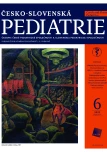Inborn errors of amino acid, organic acid metabolism and disorders of the urea cycle
Authors:
Honzík Tomáš; Zeman Jiří
Authors‘ workplace:
Klinika pediatrie a dědičných poruch metabolismu 1. LF UK a VFN, Praha
Published in:
Čes-slov Pediat 2022; 77 (6): 370-382.
Category:
Chapters for Specialization in Pediatrics
doi:
https://doi.org/10.55095/CSPediatrie2022/066
Overview
Introduction: Inborn errors of amino acid (AA), organic acid (OA) metabolism and disorders of the urea cycle (UCD) represent a heterogeneous group of 135 different diseases caused by impaired synthesis, transport or degradation of AA, OA and ammonia. Individual diseases are rare, but the overall incidence in the population is 1:3000–4000.
Methodology: The work summarizes the clinical, diagnostic and therapeutic aspects of the most common inborn errors of AA, OA metabolism and UCD. Eight diseases are part of laboratory neonatal screening, diagnosis of other IEMs depends on clinical suspicion, determination of ammonia in the blood and rapid indication of selective metabolic screening.
Results: Inborn errors of AA, OA metabolism and UCD are clinically manifested by acute or subacute metabolic disruption with metabolic alkalosis or acidosis and subsequent hepatic, renal and / or cerebral impairment or slowly progressive brain impairment with developmental delay and cognitive decline. The first group includes OA, tyrosinemia type 1, leucinosis and UCD, which are manifested by the accumulation of toxic metabolites arising from amino acid degradation. The second group includes phenylketonuria and homocystinuria, which are associated with eye, bone and / or thromboembolic events.
Conclusion: Adequate therapy depends on early diagnosis. Elimination methods are used in patients with acute brain involvement, such as severe hyperammonaemia. In patients with chronic disease, a lifelong low-protein diet supplemented with foods for special medical purposes, vitamin therapy and chaperone therapy supporting the activities of affected enzymes and efforts to block or activate alternative metabolic pathways are used. The number of diseases in which enzyme replacement therapy or liver or kidney transplantation is used is increasing. Trials with gene therapy are underway.
Keywords:
tyrosinemia – Inborn errors of metabolism – Urea cycle disorders – phenylketonuria – homocystinuria – leucinosis – glycine encephalopathy – organic acidurias
Sources
1. Honzík T, Kožich V, Pešková K, Votava F. Laboratorní novorozenecký screening. Ces-slov Pediat 2022; 77(1): 12–18.
2. Saudubray JM, Baumgartner MR, Walter JH. Inborn metabolic diseases: diagnosis and treatment. 6th ed. Heidelberg: Springer 2016: 4–5.
3. Honzík T, Zeman J, et al. Dědičné poruchy metabolismu v kazuistikách. Praha: Mladá fronta 2016.
4. Kolářová H, Honzík T. Charakteristické klinické příznaky a laboratorních odchylky dědičných poruch metabolismu. Čes-slov Pediat 2018; 73(6): 348–364.
5. Honzík T, Zeman J. Výživa u dědičných metabolických poruch. In: Kohout P, et al. Klinická výživa. Praha: Galén 2021: 779–798.
6. Blau N, Duran M, Gibson KM, et al. Physician’s guide to the diagnosis, treatment, and follow-up of inherited metabolic diseases. Heidelberg: Springer 2014.
7. van Wegberg AMJ, MacDonald A, Ahring K, et al. The complete European guidelines on phenylketonuria: diagnosis and treatment. Orphanet J Rare Dis 2017; 12(1): 162.
8. Zemanova M, Chrastina P, Sebron V, et al. Extremely low birthweight neonates with phenylketonuria require special dietary management. Acta Paediatr 2021; 110(11): 2994–2999.
9. Mayorandan S, Meyer U, Gokcay G, et al. Cross-sectional study of 168 patients with hepatorenal tyrosinemia and implication for clinical practice. Orphanet J Rare Dis 2014; 9: 107.
10. Frazier DM, Allgeier C, Homer C, et al. Nutrition management guideline for maple sirup urine disease: an evidence and consensus-based approach. Mol Genet Metab 2014; 12(3): 210–217.
11. Morris A, Kožich V, Santra S, et al. Guidelines for the diagnosis and management of cystathionine beta-synthase deficiency. J Inherit Metab Dis 2017; 40(1): 49–74.
12. Hoover-Fong JE, Shah S, van Hove JL, et al. Natural history of nonketotic hyperglycinemia in 65 patients. Neurology 2004; 63: 1847–1853.
13. Forny P, Hörster F, Ballhausen D, et al. Guidelines for the diagnosis and management of methylmalonic acidaemia and propionic acidaemia: first revision. J Inherit Metab Dis 2021; 44(3): 566–592.
14. Boy N, Mühlhausen Ch, Maier EM, et al. Proposed recommedations for diagnosing and managing individuals with glutaric aciduria type I: second revision. J Inherit Metab Dis 2007; 30(1): 5–22.
15. Häberle J, Burlina A, Chakrapani A, et al. Suggested guidelines for the diagnosis and management of urea cycle disorders: first revision. J Inherit Metab Dis 2019; 42(6): 1192–1230.
Labels
Neonatology Paediatrics General practitioner for children and adolescentsArticle was published in
Czech-Slovak Pediatrics

2022 Issue 6
Most read in this issue
- Inborn errors of amino acid, organic acid metabolism and disorders of the urea cycle
- Epidemiological and clinical characteristics of paediatric inflammatory multisystem syndrome temporally associated with SARS-CoV-2 (PIMS-TS) in the Czech Republic
- Supracondylar fractures of humerus in children – overview
- Treatment of sleep disordered breathing with non-invasive positive pressure ventilation (NIV) – our experience
